 |
||
|
||
| ||
By Maxim Lyadov
Philips is mainly famous for its home audio and video equipment. In the PC multimedia sphere the company makes a series of inexpensive multimedia acoustic systems. A year ago the company also released sound cards for the USA market with "Edge" suffix: a 2-channel Rhythmic Edge (PSC702), a 4-channel Seismic Edge (PSC704) and a 6-channel Acoustic Edge (PSC706). 
This year the company plans to launch models with the same names, but changed in their functionality: 4-channel Rhythmic Edge (PSC703), 6-channel Seismic Edge (PSC705) and 6-channel Acoustic Edge (PSC706). The latter card differs from the PSC705 in software package and in the presence of S/PDIF In. The recommended retail prices are $49, $79 and $99 respectively (OEM-versions will be available cheaper).  
Seismic Edge (PSC705) Production of the 2-channel version at $49 (PSC702) by Philips is a bold step since a 6-channel card with the same QSound algorithms on the ForteMedia FM801AU chip with S/PDIF in and out is only $30-40. That is why the refusal from a 2-channel version and cutting prices for a 6-channel one for the European market makes me feel optimistic. Today we are going to test the renewed models Rhythmic Edge (PSC703) and Seismic Edge (PSC705), while the Acoustic Edge (PSC706) will be examined in the near future (we hope for it). General characteristics
Sound processorThe card is based on the PCI audio accelerator SAA7785 ThunderBird Avenger. This chip is a DSP which accelerates QSound 3D algorithms on a hardware level including:
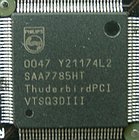
The chip measures 14 X 14 mm and is similar to the FM801. The ForteMedia chip is a HSP (host-based signal processing) solution, i.e. it partially accelerates audio data processing: sampling frequency conversion (SRC), digital mixing and DOS support. Other functions are realized on a software level, at the expense of the CPU. That is why FM801 based cards cost not much. But the Philips' chip is completely programmable DSP. The specification of the processor says: "The SSA7785 ThunderBird Avenger is a true hardware audio accelerator. CPU consumption is minimized by processing sample rate conversion, panning, mixing, 3D virtualization, filtering, music synthesis, multichannel conversion, and gameport functions in the hardware DSP". Unfortunately, no information on performance of this chip in the MIPS is given in the documentation. Possibilities of the the chip when it operates a digital signal are of great interest. SAA7785 ThunderBird Avenger has the IEC958 Consumer version of the digital protocol S/PDIF as well as the transceiving pair of the sound bus Inter-IC (I2S). This interface, unlike the S/PDIF, has synchronization lines (Word Select Clock, Bit Clock) and here can work in Master or Slave modes at 32.0, 44.1 and 48.0 kHz. The S/PDIF supports the same sampling frequencies, while the bit capacity can reach 24 bits. The S/PDIF out supports a mode of output of digital data, that is why pass-thru of the DolbyDigital5.1/DTS signal can be provided. The S/PDIF IN is supported via the I2S, but I don't know what it means. The 128-pin chip has a separate for S/PDIF IN 27th pin marked as Reserved. You can connect a respective connector of the S/PDIF in to it via the buffer. But it's better to take a model Acoustic Edge (cost higher by $20) which has 2 digital INs. Complete setBoth cards ship in the OEM package, i.e. with a CD with drivers and utilities, a CD-DA analog cable and the Yamaha's certificate with a series number to the XG MIDI soft synthesizer S-YXG50. The CD contains:

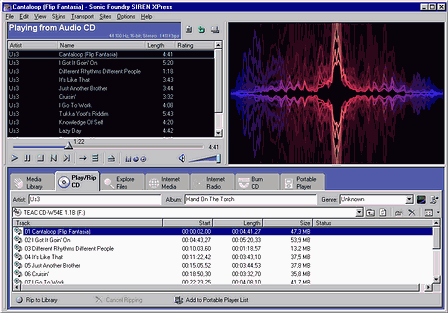
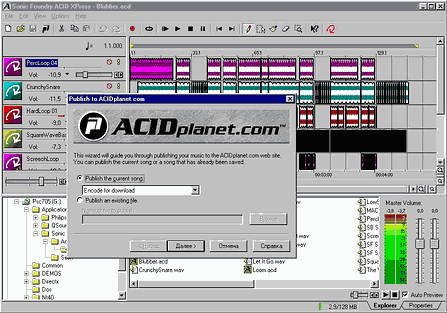
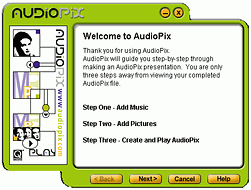
AppearanceBoth 703 and 705 cards have the same design of the printed-circuit card. The 703 lacks for one codec (2-channel SigmaTel STAC9721) and its related part of the scheme (operational amplifier, capacitors and resistors). Besides, they differ in implementation of digital S/PDIF outputs: the Seismic Edge has a minijack which combine digital and analog outputs, while the Rhythmic Edge has a coaxial RCA connector. 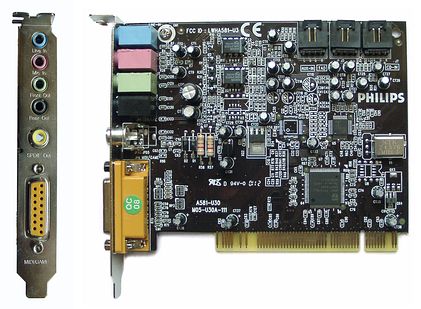
4-channel Rhythmic Edge (PSC703) 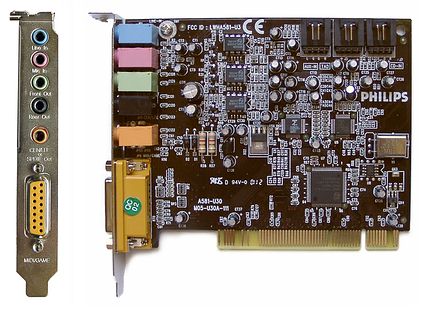
6-channel Seismic Edge (PSC705) The color connectors look like plastic, but they are only covered with plastic while inside are metallic. On the one hand, the requirements of the PC99 standard are met, as far as the color of the connector is concerned (line-in is blue, mic-in is red, front-out is green, rear one is black, center/sub is yellow). On the other hand, the connector has a large connection surface and is firm. As usually, there are three analog connectors onboard: AUX-in, TAD, CD-in. In the 6-channel Seismic Edge (PSC705) the digital output is combined with the center/sub output, like in the Live! 5.1 and Santa Cruz. I don't like this solution since a user who has a consumer receiver with 6 analog inputs and a digital S/PDIF IN will have to make a choice whether to connect the card in a digital mode and improve stereo quality (but the multichannel feature disappears) or connect the card to the receiver in an analog mode (but in this case music doesn't have the highest possible quality). If you want to avoid this problem, then buy the 6-channel Acoustic Edge (PSC706). It has separate (digital and analog) connectors. Positions of the connectors and possibilities of the Acoustic Edge can be looked at on the scheme below: 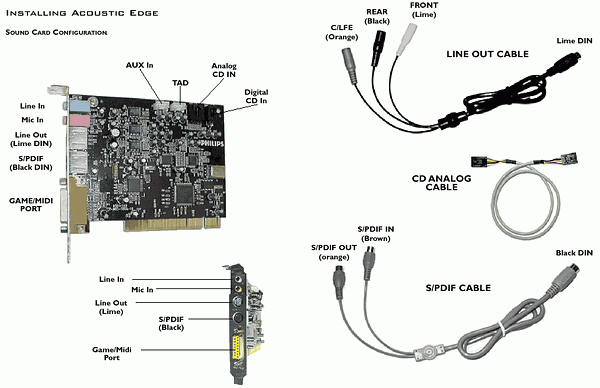
Let's summarize the differences between the models:
Technical detailsThe cards are have widespread codecs SigmaTel STAC9708 and STAC9721. Such chips equip Live!, Live! 5.1, Vortex, Vortex2, Genius 5.1 and other cards. 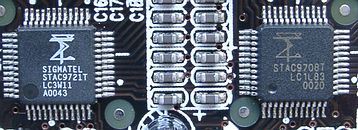
You may be surprised why Philips doesn't use own converters in these cards. But Philips doesn't deal with production of AC'97codecs. The Philips UDA1330A and UDA1334A chips installed in the Creative products are low-cost stereo filter DACs with I2S interface (!). And although the ThunderBird Avenger supports partly the I2S, the AC'97 codec from SigmaTel is the only right solution for all required analog INs and OUTs. 
Operational amplifiers on outputs of all 3 channels are very big. They are NE5532N chips from Philips. According to their specifications, they may be used in professional equipment. The level of output voltage is up to 10 V (RMS)! That is why I couldn't set volume on my 32-Ohm headphones Philips HP600 higher than a 20% mark on the mixer. But if you have high-impedance headphones or small passive speakers, then you will be pleased. TestsWe used RightMark Audio Analyzer v. 2.0 program for all sound cards under examination with the EgoSys Waveterminal 2496 card being used as the reference one. Contestants:
Operating mode: 48,000 Hz, 16 bits
In this test the Philips card showed excellent results: the lowest noise level and the lowest distortions! The worst characteristics are given by the front output of the Live! 5.1, and the best ones are shown by the rear output of the Live! 5.1. Below are the final scores given by the test program. The Philips Seismic Edge card lacks for only 1 dB in the AFC flatness to get "Very good". Operating mode: 44,100 Hz, 16 bits
A 44.1 kHz mode is very tough for sound cards implemented in an old AC'97 v. 1.0 standard (with a fixed frequency of 48 kHz). The manufacturers could have made codecs and chips with a variable AC-link bus frequency not to cripple audio devices with imperfect real-time algorithms SRC. Analog Devices has followed this way (codec with AC-link's variable frequency from 7 to 48 kHz in 1 kHz steps). Its codec AD1885 really corresponds to v.2.1 of the AC'97 specification, and characteristics of the codec at 48 and 44.1 kHz are equal. The AD1885 is a low cost codec and its parameters obtained in the review Integrated AC'97-sound on Intel D815EFV motherboard are better than those shown in the table only in the AFC flatness part. The DR and stereo crosstalk of the Analog Devices products yield a bit to usual sound cards in their characteristics. Music testsThere is something special in this section. My assistant and me have conducted so-called "blind audio tests". The computer used:
sound cards:
Once the computer had 5 sound cards at the same time with the Genius SM Live 5.1 being the fifth one. 
Just look at the photo: 
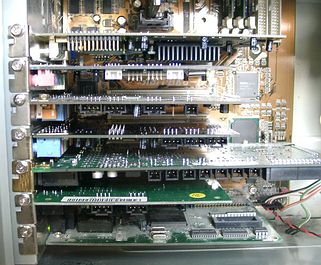
Two experts with good musical ears took part in the test. Both are professional "live" musicians and experienced in listening of equipment from Low- to Hi-End class. The goal of the experiment was to find out differences between three typical middle-level modern sound cards ($75 - $200). Sometimes we enabled a professional sound card EgoSys WaveTerminal 2496 without giving a notice about it to the experts ($350). To create a real sound computer environment we have decided to conduct two series of tests: with 2.1-part of good-level wooden computer acoustic system (F&D IHOO 5.1) (http://www.digit-life.com/articles/ihoo51/index.html) and with average-quality Hi-Fi headphones (Philips HP600, MSRP: $30). At the beginning of the tests the volume of all cards was set to be equal, all timbre regulators, microphone preamps, equalizers and mixer inputs (but for Wave and Master) were disabled. At the beginning of each new composition we listened to the reference card WaveTerminal 2496. After that an expert listened to 4 sound cards in a random sequence (including the reference one) at intervals of 30 sec for reinstallation of the current card in the Windows (in order to set it as a default sound device) and for required commutation (choosing input by pressing the required button on the IHOO amp part). Each card received a mark according to a 6-score system:
None has received a mark lower than "4". The tests were held during 2 hours with a coffee break :). In a real life you will hardly notice any difference between these cards if you will be listening to them through computer speakers. First tests: speakersThe compositions were played on the Teac CD-RW 54E drive in WinAmp player, data were read via IDE bus with the CD Reader plugin used. Composition 1. Us3, "Hand on the Torch", #1 "Cantaloop (Flip Fantasia)". This one is a rather modern, of 1996, acid-jazz composition. It's very transparent music with samples of live instruments rich of timbres. It's very pleasant to listen to it. All cards have coped with this compositions perfectly, with the leader being WT2496, whose sound was especially live and rich. Composition 2. Sara Brightman, "The Andrew Lloyd Webber Collection", #1 "The Phantom of the Opera (w Michael Crawford)". Tender but strong soprano, sympho-rock style. The Live! 5.1 has won due to its expressive mids. The WT2496 is close on the heels. Composition 3. The Corrs, "in Blue" album, #2 "Give Me a Reason". The album is bent to the electronic music, but it keeps lightness of harmonies and Irish coloring of melodies. But this melody was very difficult for the contestants. The first place is taken by the Hercules Theater XP which is followed by the WT2496.
The WaveTerminal 2496 has the highest score (it proved that a system must be well-balanced: it doesn't make sense to buy a $350 card for 5.1 speakers and an amplifier priced together at $160, though F&D IHOO 5.1 plays as if priced at $300). Such card must be provided with something not less than $600 (entry-level models of active studio monitors), or better priced at $900 (it's already a 2.1 set Sirocco Pro!). The other cards have almost equal scores. Second tests: headphonesWe have decided to listen to low-bitrate MP3 compositions with headphones. WinAmp player with a Fraunhofer decoder. Composition 1. Todd Terry "It's Over Love". Beautiful and professional woman pop-vocal. As for me, I liked all cards, but the Theater XP was the most charming (Hercules developers added highs and lows in the headphones. But my assistant is mostly pleased with the Creative Live! and Philips SE. Composition 2. Nana "He's coming". Pleasant opera duet and modern music. I liked the WT2496 best of all, but the others sounded not bad as well. My assistant prefers the Live! and Philips. Composition 3. T-Power "Mutant Jazz". Mid-90s, tech-step, the classics of modern electronic music. Live saxophone samples. The composition is digitally recorded to a computer from a compact cassette and compressed into MP3. For those who used to CD-DA it's very noisy recording and a tough test. I heard no significant difference between the cards. The sound is average. My assistant still prefers the Live!.
The Live! has the highest score, but the competitors perform very close... Due to imperfection of the source material, some compositions sounded better, some - worse due to added different coloring by different cards. The reference card had the minimal coloring and relatively better depth and width of the sound. The Philips Seismic Edge is not the first, but is not the last either. The card's got "Very good" for reproduction of music through headphones in the most part of cases due to special sound processing (tone control wasn't implemented, though timbre correction seemed to be present). When tone control is enabled it works fine (at least not worse than that on the Live! series cards. 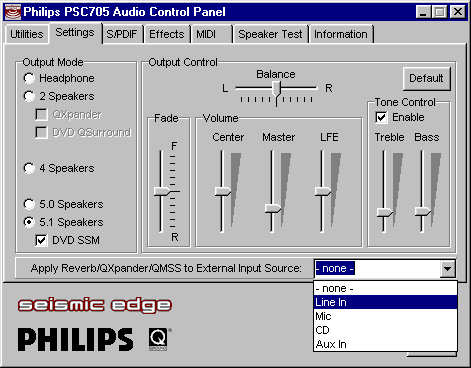
For 2-speaker configuration of the Philips cards when listening stereo sources you can choose a proprietary stereo base expansion algorithm QXpander. The sound becomes really three-dimensional. Little high-quality reverberation gives some extra depth. The powerful DSP from Philips allows adding all these effects in a real-time mode, including analog sources: Line In, Mic, CD, Aux In. The QXpander is much better than that pseudo 3D sound realized in, for example, SigmaTel codecs. DVD QSurround is virtualization of 4 or 5.1 speakers via 2. It requires support of decoding and sending to 6 virtual analog outputs by a program DVD player. We tested it with several DVD trailers and revealed high quality of this playback mode. In some cases you may not even notice the difference from a 5.1 mode! We have already seen a similar technology of Sensaura where it is called Virtual Theater Surround. The virtualization quality of QSound's and Sensaura's systems are equally high. The Sensaura has, though, a lot of fine settings for a definite acoustic system, room and audience. The DVD SSM mode (Small Speaker Mode) is similar to the Bass Redirection option of Live! 5.1 sound cards. It makes possible to turn up the bass level for a subwoofer and mix a low-frequency signal from another channels and redirect it to the sub. This one, thus, helps other speakers to playback low frequencies. It can be useful not only in movies but also in games. Tests in gamesThe following 6-channel sound cards were chosen for tests in games:
It's interesting how high can be a quality level of QSound algorithms in reality if they are realized in such a powerful DSP as Philips SSA7785 sound chip. Test system configuration:
In order to avoid influence of libraries of one card on another and other "interference" effects (for example, overwriting 3D sound API dll-s from Sensaura) we have created a template partition with only an operating system and all necessary games. The Norton Ghost helped to save it in an image-file, and then the partition was loaded each time for each card. We tested a card by card installing only one each time. Then we installed drivers for a definite sound card on the Win98SE + DirectX 8.0a. The following games were used for examination of sound:
All these games refer to the type First or Third Person Shooter. In such games positioning of sources and quality of the sound has a greater effect on a game atmosphere than in other types of games. Besides, these games are the most popular now. And developers of these games can afford competent experts in sound. So, Creative SBLive! 5.1It's a reference card for the game with EAX 2.0 interface. So, this card has the best quality of sound, the best presets of reverb in these games. Note that the EMU10K1 has also the best for today algorithms, as we assume, of stream mixing in a real time mode at the expense of a powerful DSP, and uses professional technologies of EMU and Creative in MIDI. It makes sound very sharp (in comparison with other mainstream sound cards). Philips Seismic EdgeAll games has a complete support of the EAX 2.0. All sounds are very sharp. But in my opinion, the subwoofer's channel amplifies low frequencies too much. Like in the Live! 5.1, games use all 6 channels if "6 speakers" option is enabled. In Soldier of Fortune and Hitman some sounds disappear, what spoils the general impression. By the way, in the Deus Ex (Unreal Tournament engine) my computer hung in every 5-10 minutes of the game, because, I think, the Philips drivers were too raw. But the drivers are constantly being updated. Genius SoundMaker Live 5.1Despite the latest drivers from ABIT (21.06.01) for AU10, the Genius SoundMaker Live 5.1 doesn't support EAX 2.0. That is why the reverb was completely absent. But one can force the reverb in the card's cotrol panel. The DirectSound3D sound is quite decent (if you don't set the channel in the mixer higher than 50%) The Serious Sam game had some wheeze in the game and when navigating the menu. Turtle Beach Santa Cruz and Hercules Game Theater XPBoth cards have the same DSP and codecs on the printed circuit board. Drivers and algorithms of 3D sound are based on the Sensaura technologies. The EAX 2.0 is realized excellently, though the sound reproduced by this API of Creative differs from the original one in timbre coloration. The Santa Cruz, as compared with the Game Theater XP, has a virtual mode 5.1, where 4 real MultiDrive positioning channels turn into virtual 6. It's not bad because you can enjoy sound coming from the subwoofer in games, while the Hercules doesn't allow it. We have to note that the reverb engine of the Sensaura is a bit weaker than that of the QSound and Creative, while positioning is excellent (equal or even better). Besides, the card's settings can be adjusted for a definite person... CPU utilization testsHere we used a benchmark integrated into the Serious Sam game. The tests were carried out on a computer with Athlon 1333. The accuracy of them hovers around +/- 0.1 fps. The results of the Genius in the EAX mode are absent since the current version of the drivers is incompatible with v.2.0 of this standard in W98SE. The low resolution shows much better how the cards load the computer, though this resolution isn't used in real games. 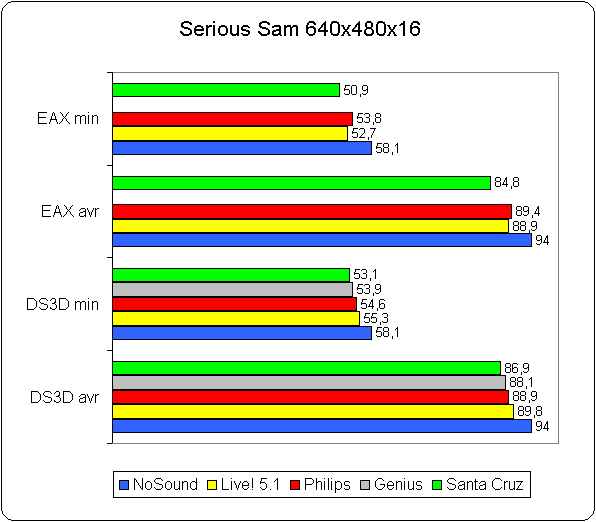
It's the first time when the Live! card in the EAX mode has abandoned its prime position (in fps)! It proves that the reverb algorithms of QSound load the processor to the least degree. DS3D shows that the EMU10K chip is the fastest solution in DS3D for today. The middle resolutions can already reflect cards' performance in a real life. 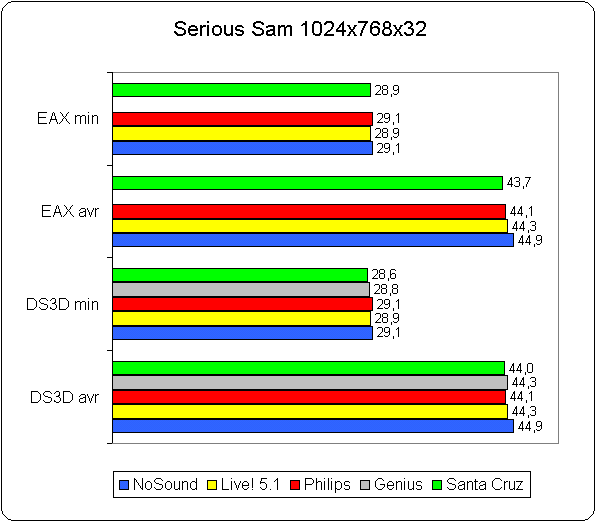
The cards differ only within the inaccuracy of measurements. That is why with a modern processor you may forget about the degree of influence of sound on the performance. ConclusionThe Rhythmic Edge and Seismic Edge from Philips are modern and not very expensive multichannel audio solutions. They will suit a wide range of users due to their functionality and high quality of implementation. Highs of the Rhythmic Edge and Seismic Edge:
Lows of the Rhythmic Edge and Seismic Edge:
Write a comment below. No registration needed!
|
Platform · Video · Multimedia · Mobile · Other || About us & Privacy policy · Twitter · Facebook Copyright © Byrds Research & Publishing, Ltd., 1997–2011. All rights reserved. |